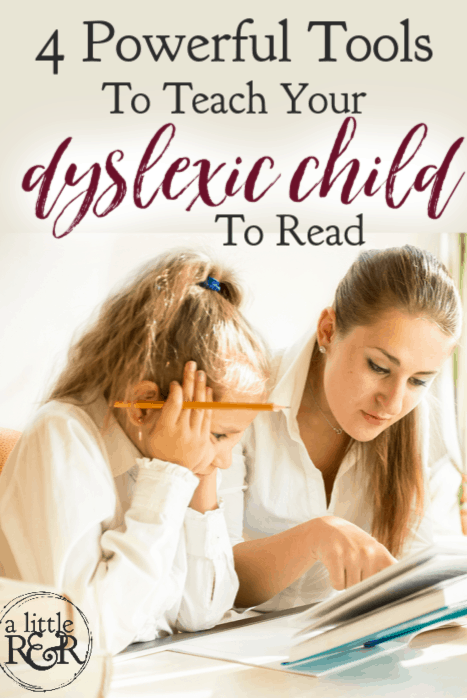4 Powerful Tools to Teach Your Dyslexic Child to Read
I hope you love the products and resources I recommend here at A Little R & R. Just so you know, it is possible that I get a commission and collect income from the links on this page. Click here for more info. I am not a doctor, none of the information on any of these pages pertaining to the Ketogenic Diet or Adrenal Fatigue should be considered medical advice and should not replace the care of your personal physician. I am simply eager to share the information I have learned while on my own journey to health. Before you embark on this journey, please consult with your physician.

Does your child struggle with reading?
Do you find they have trouble following words on the page or deciphering what they read?
Perhaps you’ve suspected that he or she is dyslexic or they’ve recently been diagnosed.
The powerful tools shared below have been used by homeschooling moms to help dyslexic children move from trouble readers to power readers.
4 Powerful Tools to Teach Your Dyslexic Child to Read
The comments you get from people alone can make having a dyslexic child just that much more daunting: “Isn’t she reading yet?” “Oh well,my Mary was reading to her brothers and sisters at 4!”
It can make you want to scream because your child may begin to cry just at the very sight of a book.
1. Bob Books and I Can Read It!
A good place to begin is with the Bob Books because they start off by teaching basic phonics and have just a few words per page.
From there you can graduate to the I Can Read It! readers. They have 3 readers and fun reading books for each level.
 2. Time Limits
2. Time Limits
Reading even just one sentence can be traumatic at times, so after completing the Bob Books it may be a good idea to set a time limit for reading rather than a page limit.
One page can seem so long and too much to a dyslexic child.
If you have a child with a learning disability, you are well acquainted with the fact that some days are awesome and others are just horrible.
You may want to begin with a 5- 10 minute limit at first.
After a few weeks your child will begin to realize that he or she is reading more and more within that limit.
That’s progress, and it can be very encouraging for both the child and the parent. Feel free to lengthen the limit as you see appropriate.
3. Abeka for phonics
Many homeschooling moms have a love- hate relationship with Abeka.
Those who are creative spirits may find them confining. But their repetitiveness, however annoying and boring, can be helpful in the end.
They have online classes your child can stream and watch, or you can buy the teacher’s manual and books and teach the materials yourself.
You may find after watching the classes, that you need to go back and repeat the phonics rules with your child over and over.
In fact, recording them and having your child sit with the book and repeat the rules over and over along with the recording can be helpful.
4. Reading in Color
Some types of dyslexia are helped by reading though a pink, blue or yellow overlay.
In many cases the colored overlays have been found to help with perception.
These thin tinted pieces of plastic can be purchased online, or some parents have simply found clear plastic folders lying around at home and made use of them.
However you decide to go about trying this, it has been a huge step forward for many.
Every parent wishes they could say that they were the picture of patience and love all the time and a huge rock for their child, but reality has a way of showing us how human we are.
- There are days you yell
- Days you may skip reading because you can’t deal with listening to your child
- Days you think you’ll never get there.
And then there will be
- Days you see progress, and days you feel encouraged
- And days you are proud!
So if this is one of those days when you’re feeling like a horrible mom and are looking for something, anything to make it easier; remember, you are looking for help right now, and that makes you a good mom!
You will get there.
Just take it one step, or one Bob Book, or one colored overlay at a time!
Here are the other posts I wrote on MERLD:
6 Things You Need to Know About Homeschooling a Kid With MERLD
6 Things I Learned About Homeschooling a Kid With MERLD
Why We Chose to Homeschool Our MERLD Son
Our Curriculum Choices for the 2019-2020 School Year
5 Ways We Make Summer Learning Fun
My Favorite Homeschool Planner
School Starts Today and Here’s the Thing…
10 Things I’ve Learned After One Month of Homeschooling
- Freedom in Christ FREE 14-Day Challenge for Women - July 23, 2024
- 10 Bible Verses for Freedom in Christ – FREE Download - July 16, 2024
- Walk Free In Christ – the Book of Galatians Workbook – FREE DOWNLOAD - July 3, 2024










